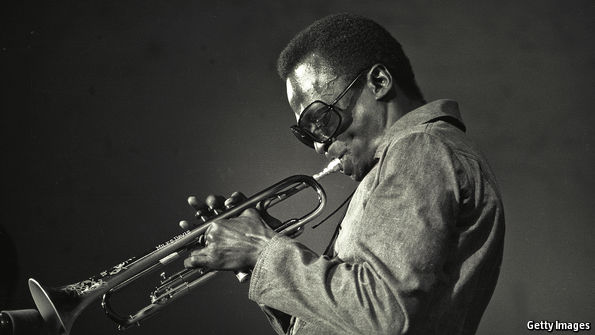http://www.economist.com/news/books-and-arts/21697207-how-distinguish-good-jazz-bad-steps-heaven?frsc=dg%7Ca
Steps to heaven

How to Listen to Jazz. By Ted Gioia. Basic Books; 272 pages; $24.99 and £16.99.
JAZZ is not a popular art-form. To its many detractors, it amounts to little more than pretentious noodling, based as it is largely on improvisation. To others, it is simply mystifying. How can an entire genre be made up of playing, again and again, variants of show tunes that were mostly composed in the 1930s and 1940s?
Ted Gioia understands why people find jazz so esoteric. The problem, as he sees it, is that no one has ever bothered to explain what “good” or “bad” jazz really is. Critics hold strong opinions on whether Charlie Parker or John Coltrane is the better saxophonist, but rarely do they explain “what they [are] listening for”. Mr Gioia’s job is to teach jazz-lovers how to assess the music and persuade sceptics to give jazz a go.
Mr Gioia has produced a fascinating book. He takes the reader through the most important ingredients of jazz, explaining, for instance, how “swing” is more than syncopated, finger-tapping rhythm. A bass-player and drummer who sound comfortable in each other’s company is one sure sign of swing. (Listen to Elvin Jones and Jimmy Garrison, playing with Coltrane, for instance.) Unlike amateur outfits that feel the need to overplay, the best groups can swing without playing many notes. In Keith Jarrett’s trio, the pianist goes for long stretches without even using his left hand, but the listener barely notices until it reappears, upon which it makes the music sound even richer.
Most useful to the uninitiated, the book provides tips on what good improvisation really means. Bad players tend to rely heavily on a small number of rhythmic and harmonic patterns in their phrases—licks containing a certain number of notes, for instance, or a tendency to begin or end their phrases at a certain place in the bar. Listen to such an improviser for more than a minute or so, and “even novice listeners will perceive an inescapable monotony,” says Mr Gioia. The best players, including Louis Armstrong and Miles Davis (pictured), never fall into such traps, however.
In his enthusiasm, Mr Gioia’s analysis of improvisation sometimes veers into abstraction. Take his discussion of what he calls “intentionality”, which he says is another crucial element of good soloing. He defines this as “a musical phrase that reveals the total commitment of the improviser”—hardly an illuminating description. Yet read the book within easy access of a music-streaming service or YouTube, and Mr Gioia’s commentary suddenly feels much more useful. A middling trumpeter (say, one in a student band) appears to struggle against the music, and will finish a phrase upon running out of breath. Davis’s phrases on the trumpet, by contrast, have a clear beginning, middle and end. No note is wasted and the accompanists seem to work around him. (For an excellent example of this, see his opening solo in “Spanish Key”, recorded in 1969.)
Mr Gioia also delves into musical theory, in a way that will help both jazz neophytes and experts understand what they are listening to. The best jazz musicians do not worry much about producing clearly defined notes (the do-re-mi system that structures Western classical music). Instead they look to make particular sounds—bending notes and creating unusual timbres—which is a consequence of the heavy African influence on jazz. The emphasis on sound over notes is especially pronounced in Coltrane’s late work.
Alongside the tips for listening, Mr Gioia’s book gives a helpful overview of how jazz has evolved since its beginnings in turn-of-the-century New Orleans. Buddy Bolden, a cornet-player in the Big Easy of whose music there are no recordings, is credited by many with inventing “jass”. Like the rest of the book, the majority of this discussion focuses on long-dead musicians (many of whom met untimely ends thanks to debilitating drug habits). As if to compensate for the book’s backward-looking bias, at the end the author lists 150 contemporary jazzists “who deserve your attention”.
“How to Listen to Jazz” is not a long book, but it emphasises a beautiful point about the genre, a point that applies to no other sort of music. When you see a live performance, you may be watching a 60-year-old musician playing a 100-year-old piece; but what is produced on stage has never been, and will never be, played again. Jazz is undoubtedly struggling, but as an introduction to why its remaining fans are so devoted, Mr Gioia could not have done a better job. Through him, jazz might even find new devotees.